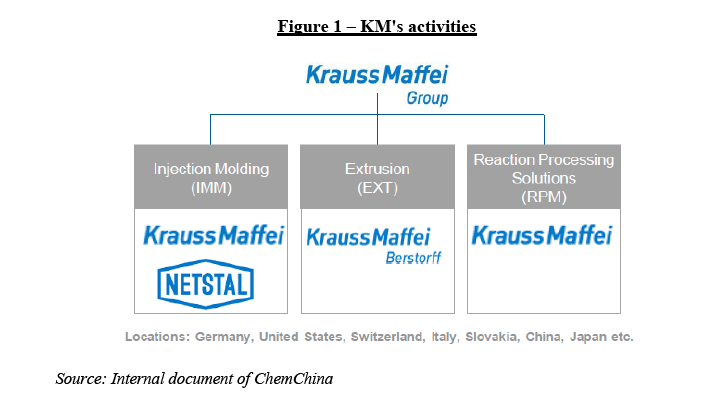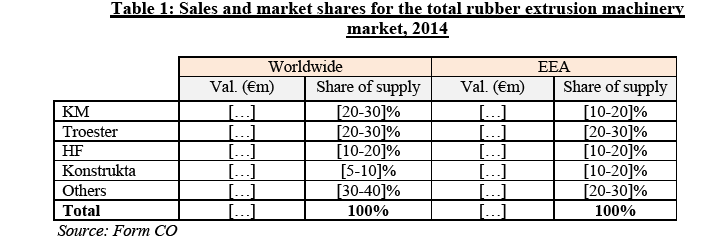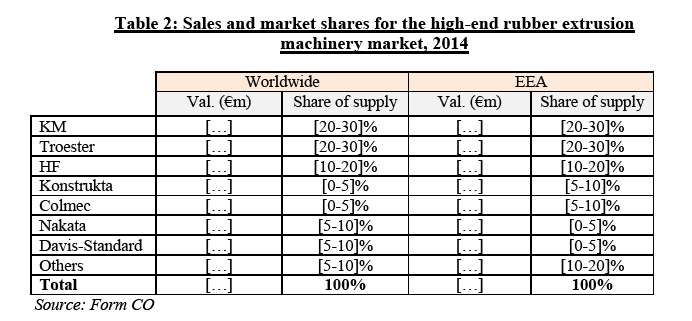Commission, March 15, 2016, No M.7911
EUROPEAN COMMISSION
Judgment
CNCE / KM GROUP
Dear Sirs,
Subject: Case M.7911 – CNCE / KM GROUP
Commission decision pursuant to Article 6(1)(b) of Council Regulation No 139/2004 (1) and Article 57 of the Agreement on the European Economic Area (2)
(1) On 9 February 2016, the European Commission received a notification of a proposed concentration pursuant to Article 4 of Council Regulation (EC) No 139/2004 by which the undertaking China National Chemical Equipment Co., Ltd. ("CNCE", China) wholly owned by China National Chemical Corporation ("ChemChina"), a state-owned enterprise, acquires, within the meaning of Article 3(1)(b) of the Merger Regulation, control of the whole of KraussMaffei Group GmbH ("KM", Germany), by way of purchase of shares (the "Transaction").(3) CNCE is referred to as the "Notifying Party". CNCE and KM are collectively referred to as "Parties".
1. THE PARTIES
(2) CNCE is a wholly-owned subsidiary of ChemChina. CNCE's major lines of business include rubber machinery, chemical machinery, auto parts manufacturing, vehicles and vessels construction and maintenance, and engineering trade services. ChemChina is the largest chemical enterprise in China and a chemical conglomerate under the supervision of the Central Government, with an annual turnover of over USD 40 billion. ChemChina is active, notably through Pirelli which it acquired in 2015,(4) in the production and distribution of OEM (Original Equipment Manufacturer) tyres and replacement tyres. Apart from Pirelli (held by ChemChina's subsidiary CNRC), relevant subsidiaries within ChemChina for the purposes of assessing the Transaction include notably Guilin Rubber Machinery, Yiyang Yishen Rubber Machinery, Fujian Sino-Rubber Machinery and China Chemical Guilin Engineering.
(3) KM is a global market leader in the plastics and rubber processing machinery industry. KM’s current major shareholder is Onex Corporation ("Onex"), a Canadian listed private equity fund, while its management holds a minority stake in the company. Onex acquired KM in December 2012.(5)

2. THE OPERATION AND THE CONCENTRATION
(4) On 9 January 2016, the Parties entered into a share purchase agreement. CNCE will, through various special corporate vehicles, acquire [50-60]% of KM's share capital. CRH (a Chinese state-owned asset management company) and AGIC (a private equity investment fund) will be passive financial shareholders holding respectively [20-30]% and [10-20]% of KM's share capital, without the possibility of (jointly) exercising decisive influence over KM. CNCE will acquire sole control of KM.
(5) Therefore, the Transaction constitutes a concentration within the meaning of Article 3(1)(b) of the Merger Regulation.
3. INDEPENDENCE OF CNCE / CHEMCHINA
(6) The Chinese government exercises its rights on ChemChina through the Central State Owned Assets and Supervision and Administration Commission of the State Council ("Central SASAC"), an agency of the Chinese government which owns about 125 State-owned enterprises ("Central SOEs").
(7) The Notifying Party submits that ChemChina and its subsidiaries (including CNCE) do not act as a single economic unit with other Central SOEs and that ChemChina has its own independent power of decision. It submits that Central SASAC is required to observe the fundamental principles of the separation between the ownership and operational rights of Central SOEs.
(8) Furthermore, separately from Central SOEs and Central SASAC, there are also SOEs supervised by provincial and regional/municipal authorities ("Regional SASACs"). The Notifying Party notes that there are 32 Regional SASACs supervising SOEs at provincial level, and there are many more Regional SASACs at lower levels such as the municipal level.
(9) The Notifying Party submits that Regional SASACs operate completely independently from Central SASAC and as a result, SOEs supervised by regional/municipal governments ("Regional SOEs") are independent from Central SOEs and should therefore also not (and even less so) be treated as a single economic unit with ChemChina. It states that regional governments own the Regional SOEs, have managerial appointment authority and have their own interests. Moreover, it submits that there is no direct command-relationship between Central SASAC and Regional SASACs as Central SASAC can only establish general procedures and principles, and that Regional SASACs and Central SASAC are driven by different overarching strategies and objectives.
(10) Nonetheless, the Notifying Party has provided, to its best knowledge, information on companies controlled by the Central SASAC and by the Regional SASACs.
(11) In line with the Commission's past cases,(6) activities of Chinese SOEs have been taken into consideration. However, given that the possible links between the Parties and the Chinese SOEs (7) are unlikely to give rise to serious doubts as to the Transaction's compatibility with the internal market, it is not necessary to reach a definitive conclusion on the ultimate control and the functional independence of ChemChina.
4. UNION DIMENSION
(12) The undertakings concerned have a combined aggregate world-wide turnover of more than EUR 5 000 million (8) (ChemChina*: EUR [>37 000] million; KM: EUR 1 112 million). Each of them has a EU-wide turnover in excess of EUR 250 million (CNCE: EUR […]; KM: EUR […]), but they do not achieve more than two-thirds of their aggregate EU-wide turnover within one and the same Member State. The notified operation therefore has an EU dimension.
5. RELEVANT MARKETS
(13) Both Parties are active in the supply of plastics and rubber processing machinery. In addition, CNCE also has business activities in the downstream market(s) for various rubber products, including 'premium' tyres through Pirelli.(9)
(14) The relevant markets for the assessment of the Transaction are: 1) the manufacture and sale of plastics and rubber processing machinery, and 2) the manufacture and sales of tyres.
5.1. Manufacture and sale of plastics and rubber processing machinery
5.1.1. Product market definition
(15) In a previous decision in the plastics and rubber processing machines sector,(10) the Commission has identified certain possible segmentations based on 1) the processing technology (injection moulding machinery; extrusion machinery; reaction processing machinery), 2) the end-use application for which the extrusion machinery is used (rubber; film/sheet; foam; pipe; profile; compounding; wire; fibres; yarns; and fabrics), and 3) the specification of the machinery (high-end; low-end), due to differences in terms of performance, output technical standards and runtime. The ultimate product market definition was left open.
(16) The Notifying Party submits that all plastics and rubber processing machines are ultimately used for converting plastic and rubber materials into semi-finished or finished rubber or plastic parts for various industries. On this basis, the Notifying Party considers that the relevant product market is that for the manufacturing and supply of all plastics and rubber processing machinery.
(17) For the purposes of assessing this Transaction, the Commission has looked at the various segmentations within the plastics and rubber processing machinery. The most relevant market in assessing this Transaction is the high-end rubber extrusion machinery. More specifically, the Commission has also considered whether it is relevant to identify a specific market for high-end rubber extrusion machinery for tyres.
(18) The extruders used for the production of tyres tend to differ from those used in the production of other rubber products, such as hoses for the automotive sector. According to the market investigation, the production of tyres requires extruders with a dimension ranging from 90 mm to 250 mm, whereas smaller extruders are used (up to 90 mm) for the production of other rubber products. These (smaller) are typically not used in the production of tyres.(11)
(19) The extruders used to produce tyres are in principle suitable for the production of different types of tyres. Indeed, the majority of respondents to the market investigation noted that the same rubber extrusion machinery can be used to produce most types of tyres.(12)Furthermore, KM’s competitors manufacture rubber extrusion machinery suitable for the vast majority of tyre types.(13)
(20) The Commission considers that, for the purpose of this decision, the exact scope of the product market can be left open since the Transaction does not give rise to serious doubts about its compatibility with the internal market under any plausible definition of the product market.
5.1.2. Geographic market definition
(21) In its past decision,(14) the Commission has considered the geographic scope of the market(s) for plastics and rubber extrusion machines to be at least EEA-wide, if not worldwide.
(22) The Notifying Party submits that in the present case the exact market definition can be left open, because no competitive concerns arise under any plausible definition.
(23) For the rubber extrusion machinery, the market investigation provided strong indications that the geographic scope of the market is worldwide. The majority of tyre manufacturers that responded to the market investigation confirmed that all the key suppliers of rubber extrusion machinery are active at worldwide level.(15) One customer mentioned that "All of them are international companies selling equipment all over the world".(16) Another observed "All of the above mentioned sell globally".(17)
(24) In conclusion, the Commission considers that there are strong indications that the geographic scope of the market is worldwide but, for the purpose of this decision, the precise dimension of the geographic market can be left open, as the Transaction does not give rise to serious doubts about its compatibility with the internal market under any plausible alternative geographic market definition.
5.2. Market for the manufacture and sale of tyres
5.2.1. Product market definition
(25) In previous decisions,(18) the Commission has segmented the tyres market in different categories according to the consumer targeted by the manufacturer, and distinguishing OEM and new replacement tyres.
(26) The Notifying Party submits that such segmentation of the downstream market for rubber tyres is less relevant for the analysis of the vertical competition issues raised by the Transaction. The market investigation (19) has confirmed that the machinery sold by KM is not specifically targeted at niche segments within the manufacture of rubber tyres and downstream customers require the same machinery regardless of the product segment (e.g. passenger car tyres or truck tyres) of the overall tyre market on which they operate.
(27) Therefore, the Commission will conduct its assessment focussing on the overall tyres market.
5.2.2. Geographic market definition
(28) In its past decision, (20) the Commission has considered the geographic scope of the market for OEM tyres to be at least EEA-wide, but left it open. For new replacement tyres, the exact geographic scope was also left open between EEA- wide and national level.
(29) The Notifying Party submits that the exact scope of the geographic market is of limited relevance to the assessment of any potential competition issues resulting from the vertical links created through the proposed Transaction. This has been confirmed by the market investigation (21) as customers in the downstream market typically source their supplies of processing machinery and operate their manufacturing facilities on, at least, an EEA-wide basis, if not on a worldwide basis, irrespective of the type of tyres produced.
(30) Based on the above the Commission will conduct its assessment on the worldwide and EEA-wide global tyres market.
6. COMPETITIVE ASSESSMENT
(31) Although KM's and CNCE have activities in a number of different markets, the Transaction will only give rise to vertically affected markets (22) between: 1) upstream, the manufacture of high-end rubber extrusion machinery, in which KM is active (CNCE has no activities in high-end rubber extrusion machinery); and 2) ChemChina’s downstream activities in the rubber tyre market.
6.1. The legal framework
(32) Foreclosure concerns a situation where actual or potential rivals' access to supplies or markets is hampered or eliminated as a result of a merger and those companies' ability and/or incentive to compete is reduced. Such foreclosure can take two forms: input and customer foreclosure. (23)
(33) Input foreclosure is a situation where, post-merger, the new entity would be likely to restrict access to products or services that it would have otherwise supplied absent the merger, thereby raising its downstream rivals' costs by making it harder for them to obtain supplies of the input under similar process and conditions as absent the merger. (24)
(34) Customer foreclosure is a situation where the merged entity may foreclose access to sufficient customer base to its actual or potential rivals in the upstream market and reduce their ability or incentive to compete. In turn, that may raise downstream rivals' costs by making it harder for them to obtain supplies of the input under similar prices and conditions as absent the merger.(25)
(35) For an input or customer foreclosure scenario to raise competition issues, three factors need to be taken into account: 1) the ability of the merged entity to engage in foreclosure, 2) the incentives of the merged entity to do so and 3) whether a foreclosure strategy would have a significant detrimental effect on competition on the downstream market. (26)
6.2. Market Structure
Upstream positioning
(36) Based on the Notifying Party's estimates, as illustrated by the table below, KM would have about [20-30]% of the worldwide market and about [20-30]% of the EEA market for the manufacture and sale of rubber extrusion machinery.

(37) If, however, only the high-end segment of the rubber extrusion machinery in which KM is active is considered, according to the Notifying Party, KM's market share would be around [20-30]% at worldwide level and around [20-30]% at EEA level for 2014. This market share has been higher in some of the previous years (2011, 2012, and 2013 at EEA level).

(38) The Commission's investigation undertaken in the present case has only partially confirmed the evolution and size of the market as described by the Notifying Party. (27) Moreover, the market investigation has highlighted that, looking at high- end rubber extrusion machinery for the production of rubber tyres, Rubicon, Colmec and Davis-Standard are not active in this area.
(39) The Commission's findings are more in line with the Commission's precedents, where the high-end segment of rubber extrusion machinery was estimated at 70% of the total worldwide market and at 90% of the EEA market. (28) If these proportions were applied to the present case, the worldwide market would be estimated at […] and the EEA market at […]. Accordingly, KM's market share would be [30-40]% at worldwide level and [20-30]% at EEA level.
Downstream positioning
(40) ChemChina, through Pirelli, has downstream activities in relation to the manufacture and sale of 'premium' rubber tyres. (29) The production of this category of tyres typically requires the use of high-end extruders as those supplied by KM. In 2014, Pirelli ranked […] as a producer of tyres at worldwide level and […] at EEA level (see Table 3 and Figure 3). The main competitors of Pirelli in this area are Bridgestone, Michelin, Goodyear, and Continental.

(41) The Notifying Party further submits that a certain degree of correlation can be expected between a player's share in the supply of 'premium' tyres and its share of demand as a customer on the upstream high-end extruder market. On this basis, the Notifying Party estimates that ChemChina/Pirelli's share of the global demand for high-end rubber extruders is less than [5-10]% (2014 data).
No input foreclosure effects
(42) Although KM is one of the leading suppliers of high-end extruders for rubber, the Transaction would not likely significant impact the market structure since several suppliers of this machinery will remain available on the market such as: Troester, HF, Nakata, CGEC and Konstrukta. This was confirmed by the market investigation as the vast majority of tyre producers considered that, following the Transaction, they would still have sufficient access to rubber extrusion machinery.(30)
(43) Moreover, the market investigation also provided evidence that some producers of tyres have the internal capabilities to manufacture extruders for the production of tyres.(31) On this point, one market participant observed that "we believe we have no need to set up our own extruder manufacturing capability [because] a sufficient number of extruder suppliers are still available on the market to assure us a sufficient access to rubber extruder equipment".(32)
(44) Finally, a possible input foreclosing strategy would potentially be unprofitable as ChemChina's total demand for high end rubber extrusion machinery accounts for only a limited portion of KM's total sales of such machinery. For instance, ChemChina's total order value across all suppliers accounted for less than [10-20]% of KM's sales of high-end extruders in 2014.
(45) In light of the above and of the evidence available to the Commission, and in view of the outcome of the market investigation, it appears unlikely that the merged entity would engage in an input foreclosure strategy raising competition issues.
No customer foreclosure effects
(46) Given ChemChina/Pirelli's limited position on the downstream market for tyres, it is unlikely that the merged entity will have the ability or incentive to foreclose access to significant customer base.
(47) The downstream market(s) for the supply of tyres is relatively fragmented, with Bridgestone, which is the largest player, accounting for [10-20]% of the global market. ChemChina/Pirelli's only ranks as the […] largest player on the global market for tyres.
(48) Even if ChemChina were to source all of its requirements (both high-end and low- end) from KM going forward, this would only account for less than [5-10]% of total demand of rubber machinery used for extrusion ([…] in 2014).
(49) Some of KM's competitors indicated that after the Transaction KM would likely have better access to customers in China.(33) However, they also mentioned that the Transaction "might provide opportunities with other tyre companies. There is reluctance of large tyre companies to deal with CNCE, which is part of ChemChina, a Chinese state owned company owning their competitor Pirelli.Overall, the transaction seems to have neutral effect […]".(34)
(50) In light of the above and of the evidence available to the Commission, and in view of the outcome of the market investigation, it appears unlikely that the merged entity would engage in a customer foreclosure strategy raising competition issues.
7. CONCLUSION
(51) For the above reasons, the European Commission has decided not to oppose the notified operation and to declare it compatible with the internal market. This decision is adopted in application of Article 6(1)(b) of the Merger Regulation and Article 57 of the EEA Agreement.
1 OJ L 24, 29.1.2004, p. 1 ('the Merger Regulation'). With effect from 1 December 2009, the Treaty on the Functioning of the European Union ('TFEU') has introduced certain changes, such as the replacement of 'Community' by 'Union' and 'common market' by 'internal market'. The terminology of the TFEU will be used throughout this decision.
2 OJ L 1, 3.1.1994, p.3 ("the EEA Agreement").
3 Publication in the Official Journal of the European Union No C 60, 16.02.2016, p. 11.
4 Case M.7643 – CNRC / Pirelli, 1 July 2015.
5 Case M.6754 – KM Holdings/KM Group, 19 December 2012. CNRC also controls four other tyre manufacturers: Fengshen Tires Stock Ltd. Co., Qingdao Yellowsea Rubber Co. Ltd., ChemChina Guilin Tire Co. Ltd. and Double Happiness Tire Industrial Co. Ltd.
6 See for instance case COMP/M.6082 - China National Bluestar/Elkem, 31 March 2011.
7 Central SOEs considered include Aviation Industry Corporation of China, China National Petroleum Corporation and China Petroleum & Chemical Corporation (Sinopec). Regional SOEs considered include Dalian Rubber and Plastics Machinery and Qingdao Double Star. In view of the limited activities of the companies concerned, notably in the EEA, their activities will not be discussed further in this decision.
8 Turnover calculated in accordance with Article 5 of the Merger Regulation and the Commission Consolidated Jurisdictional Notice (OJ C 95, 16.4.2008, p. 1).
9 The Notifying Party submits that ChemChina via CNRC has very limited activities outside the EEA in the production and supply of certain non-tyre rubber products (e.g., rubber conveyor belts and auto rubber hoses). […] Such activities in non-tyre rubber products do not give rise to vertically/horizontally affected markets. Therefore, these markets will not be discussed further in this decision.
10 Case M.6754 - KM Holdings/KM Group, 19 December 2012.
11 See agreed minutes of conference calls with market participants on 26 January 2016 and 29 January 2016.
12 See replies to Question 5 of Q1 – Questionnaire to buyers of rubber extrusion machinery.
13 See reply to question 2 of the Commission's request for information of 16 February 2016.
14 Case M.6754 - KM Holdings/KM Group, 19 December 2012.
15 See replies to Question 6.1 of Q1 – Questionnaire to buyers of rubber extrusion machinery.
16 See replies to Question 6.2 of Q1 – Questionnaire to buyers of rubber extrusion machinery.
17 See replies to Question 6.2 of Q1 – Questionnaire to buyers of rubber extrusion machinery.
18 See for instance case M.4561 - Continental/Matador, 8 June 2007, M.1470 - Goodyear/Sumitomo, 23 July 1999, COMP/36.041 - PO/Michelin, 20 June 2001, and M.7643 – CNRC / Pirelli, 1 July 2015.
19 See replies to Question 5 of Q1 – Questionnaire to buyers of rubber extrusion machinery.
20 See for instance case M.7643 – CNRC / Pirelli, 1 July 2015.
21 See replies to Question 6.1 of Q1 – Questionnaire to buyers of rubber extrusion machinery, and agreed minutes of a conference call with a market participant on 26 January 2016.
22 For the definition of horizontally or vertically affected markets, see Annex I point 6.3 of Commission Regulation (EC) No 802/2004, as last amended by Commission Implementing Regulation (EU) No 1269/2013.
23 See, for instance Guidelines on the assessment of non-horizontal mergers under the Council regulation on the control of concentrations between undertakings, OJ C 265, 18.10.2008, p. 7. ('Non-Horizontal Guidelines'), paragraphs 29 and 30.
24 See, for instance Non-Horizontal Guidelines, paragraph 31.
25 See, for instance Non-Horizontal Guidelines, paragraph 58.
26 See, for instance Non-Horizontal Guidelines, paragraphs 32 and 59.
27 See agreed minutes of conference calls with market participants on 26 January 2016 and 29 January 2016.
28 Case M.6754 - KM Holdings/KM Group, 19 December 2012.
29 ChemChina, through its subsidiary CNRC, also sells tyres in the EEA under its own brands, including "Aeolus", "Double Happiness", and "Windpower", which are considered low-budget brands aimed at low to mid-range customers. These activities do not significantly impact the assessment of the Transaction.
30 See replies to Question 10 of Q1 – Questionnaire to buyers of rubber extrusion machinery.
31 See replies to Question 9 of Q1 – Questionnaire to buyers of rubber extrusion machinery and agreed minutes of a conference call with a market participant on 29 January 2016.
32 See replies to Questions 9.1 and 10.1 of Q1 – Questionnaire to buyers of rubber extrusion machinery.
33 See agreed minutes of conference calls with market participants on 26 January 2016 and 29 January 2016, and replies to Question 11 of Q1 – Questionnaire to buyers of rubber extrusion machinery.
34 See agreed minutes of a conference call with a market participant on 26 January 2016.